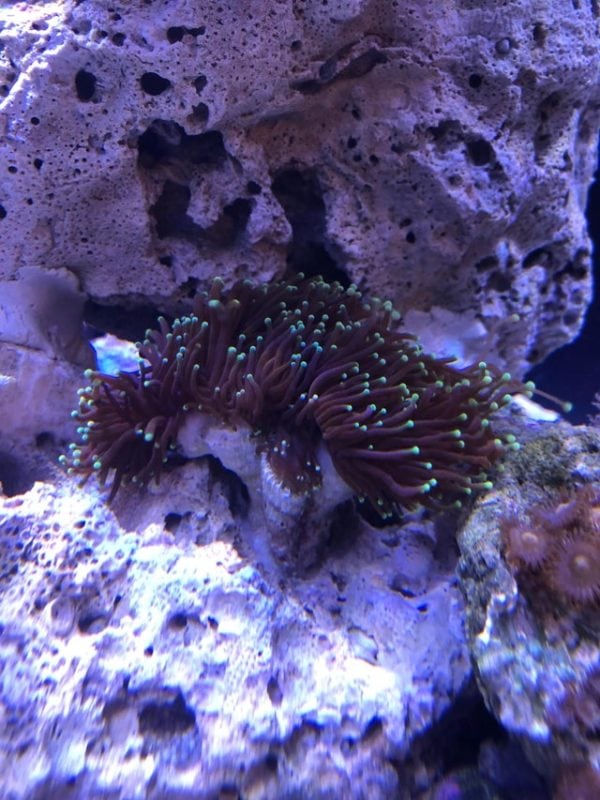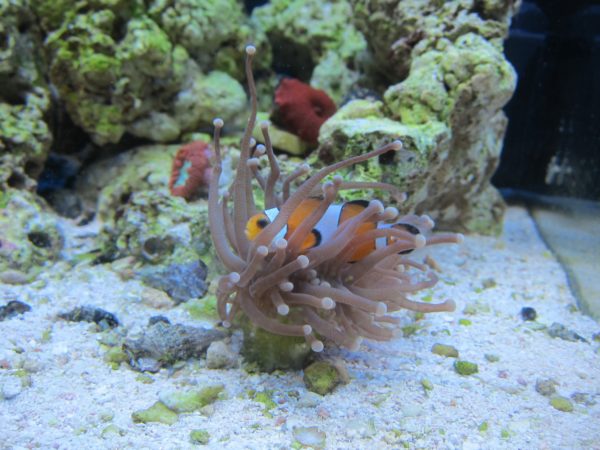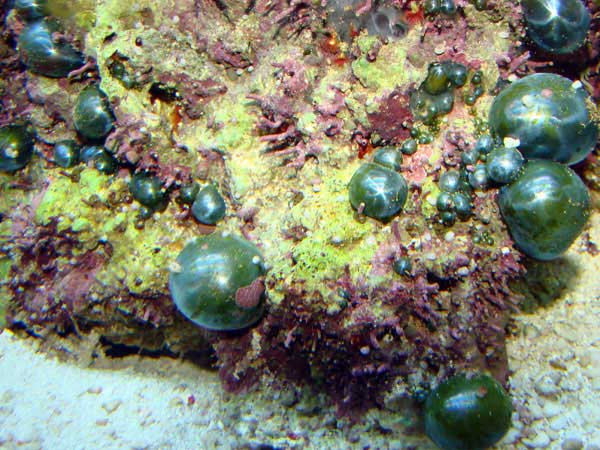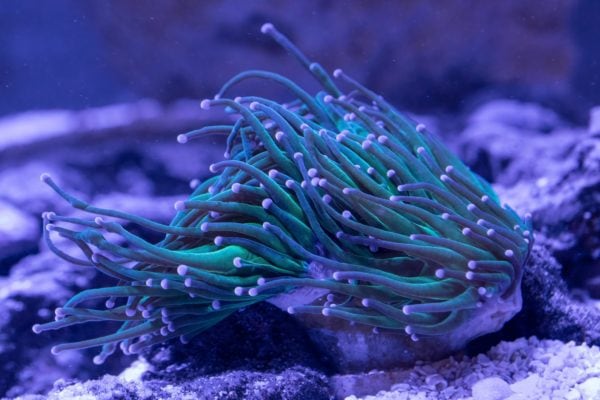Table of Contents
Torch Coral Overview
Popularly, the Torch Coral goes by the name of Pom-Pom Coral, or Cornet Coral, is one of the most aggressive LPS corals available. It is an interesting-looking Coral, with extended, thick polyps that emerge from a base of calcified stone. It’s called a Torch Coral because as water flows over it, it looks like a torch. Its large, meaty fingers may readily stretch out and move about when placed low in the tank, creating an eye-catching show. Torch corals are large polyp stony corals, also known as LPS corals. The majority of these corals have a hard, stone-like surface. They have a lot of lengthy polyps that expand and move about in response to the current in the water. Pom-Pom Coral and Trumpet Coral are other names for the Torch Coral. Euphyllia Glabrescens is their scientific name. The Caryophyllidae family includes the Torch Coral. The Torch Coral is great for beginners, but it does require some research before you can add it to the aquarium. In this article, we will be focusing more on the initial setup of the aquarium needed to keep healthy Torch Coral colonies.
| Information Chart | Torch Coral |
| Scientific Name: | Euphyllia glabrescens |
| Family: | Euphylliidae |
| Care Level: | Intermediate |
| Temperament: | Very Aggressive |
| Color: | Green, brown, yellow, purple |
| Lifespan: | Up to 75 years |
| Size: | Up to 10 inches |
| Diet: | Carnivore |
| Minimum Tank Size: | 50 gallons |
| Temperature: | 78 degrees Fahrenheit |
| Water Conditions: | Moderate Flow, 8.2 pH |
| Tank Mate Compatibility | Most marine livestock |
Torch Coral Appearance

When submerged in a strong current, the torch coral resembles a flickering flame. Polyps with long tentacles can be found in various colors, including greens, purples, pinks, browns, oranges, and yellows. Torch corals are known for their long, slender tentacles. The bottoms of the tentacles are usually darker than the circular tips of the tentacles, and they are usually a distinct hue. The tentacles of a frogspawn coral are thicker and branched, but the tentacles of a hammer coral are shorter and broader, with flattened tips.
The lifespan of Torch Coral
The typical lifespan of a Torch Coral is 75 years. They have a very long lifespan and hence can become a longtime member of your aquarium. With enough care and maintenance, they will grow to be healthy.
Torch Coral Size
The Torch Coral typically grows up to 10 inches across and another 10 inches with tentacles. Because they expand their reach for optimal feeding and territory protection, transparent sweeper tentacles may be considerably longer than conventional.
Torch corals have robust calcium carbonate skeletons and are a form of large-polyp stony coral. The torch skeletons of the Hammer Coral are branched, unlike those of other Euphyllias. Wall corals are single coral polyps with one continuous skeleton, whereas branching torches contain defined coral polyps, each with its skeleton base. Torch corals vary in size. In addition to the tiny varieties of worms (about half an inch to an inch in length), some species are quite large. They can be up to about four or five inches in length.
Natural Habitat and Origin
The Torch Coral is only found in a few parts of the Indo-Pacific region. It originates from the Marshall Islands, the Red Sea, Samoa, and Australia. Chamisso and Eisenhardt described the torch coral Euphyllia Glabrescens in 1821. Pom-Pom Coral, Branch Coral, Branching Anchor Coral, and (believe it or not!) Brain Trumpet Coral are some of the other names for this coral. E. Glabrescens can be found in a variety of reef environments. They dwell in colonies at depths of up to 131 feet (40 meters) in murky but soft waters that get indirect bright light. They contain stinging cells on their bodies to aid in the capture of small prey and to protect themselves from predators.
Torch Coral Care and Tank Set-Up
Torch Coral Tank Size and Specifications
Optimum Tank Size for Torch Coral

The recommended tank size for Torch Coral is 50 gallons. Because the Torch Coral is a relatively aggressive species, it requires a lot of room. The lengthy polyps sway back and forth, almost as though blown by a mild breeze. A 50-gallon tank would give them sufficient space to move around freely without threatening any other species.
Tank Shape for Torch Coral
One does not have to worry too much about the tank shape for the Torch Coral. Making sure that the tank is big enough will be beneficial.
Filter Type
Since the Torch Corals live in reefs, it is always better to replicate their natural habitat in the tank. The utilization of live rock from diverse tropical zones around existing reefs, or more recently, aquacultured rock from Florida, provides the primary biological filtration for reef aquariums. Deep Sand Beds are also used by some reef keepers (DSB). These are frequently used to supplement biological filtration by reducing nitrate, a waste product in an incomplete nitrogen cycle. Opponents of deep sand beds may favor a “bare bottom” or “suspended reef” that allows for more straightforward clearance of nitrate-generating debris. Protein skimmers are usually used to augment biological filtration.
Substrate
The living sand represents the sand along with the microscopic and macroscopic living inside it, such as bacteria, worms, snails, copepods, amphipods, and others.
Most of the time, at the acquisition, the sand is populated by bacteria only. The rest of the organisms are installed after contact with the living stone. Bacteria in the sand are essential in aquarium cycling. This is because they start nitrification. The rest of the living continues this circuit by denitrification.
Living stone has to be understood in its true meaning. It is a biogenous stone made of coral skeletons or inverts of other calcareous organisms. This construction makes this type of stone have a seaweed film and is populated by many micro and macroscopic organisms. So the rock is not itself alive; it is a living environment.
A living stone is an indispensable component for reef-type aquariums. This is because it contains many species and functions as a filter due to aerobic and anaerobic nitrifying bacteria.
How many Torch Coral in a 50-gallon tank?
One can put around 1-3 Torch Corals in a 50-gallon tank. Just make sure that the tank isn’t too crowded and the corals aren’t cramped together.
Water Parameters for Torch Coral
The aquarium’s water must have the salt concentration required by the fish or corals that will live in the aquarium, so this salinity will usually be between 1,023 and 1,026 ppm. Salinity must be achieved by using unique salt from commerce, from specialty shops, in no case kitchen salt. This unique ocean salt does not contain nitrates or phosphates. It helps control algae growth, and a salinity check can be done using a salimeter or a refractometer.
Water Temperature
The ideal water temperature for Torch Coral is 78 degrees Fahrenheit. A temperature level below or above this would make it difficult for the Torch Coral to survive.
Water flow rate
Well, unless you’re near a powerhead or a light source, the fringes/corners of your tank are likely to have reduced flow and light. The sections directly in front of your powerheads or gyre pumps, on the other hand, have the highest flow. When the polyps are fully stretched and gently swaying, as though in a breeze, moderate flow is attained. Swaying in a breeze, not stationary or bending as in a storm (you’re not making a hurricane). The lengthy polyps will be torn and harmed if the water flow is too fast or the current is too strong, as the current forces its way through them. A moderate water flow will guarantee that the polyps gently migrate around the aquarium.
pH Level
The perfect water pH level for Torch Coral is 8.2. The Torch Coral might experience significant adverse effects if it is overly acidic or alkaline. Bicarbonate is required for coral growth. The alkalinity of the water influences the generation of bicarbonate. As a result, it’s critical to verify that the pH level is correct. For the healthy maintenance of your Torch Coral, the calcium content in the water is vital. Calcium is well-known for its importance in human and animal bone development. While Torch Coral is neither human nor animal, it does have a skeletal skeleton that requires enough calcium to thrive. Corals also need steady levels of magnesium (1250-1350 ppm), calcium (350-450 ppm), and alkalinity (8-12 dKH) to grow.
Cycling the aquarium should be done with a lot of patience after the live stone has. The sand will also introduce a piece of fish, shrimp, a little fish food, or almost any organic matter to decompose and start cycling. We do not want to add torch corals or any type of coral if the aquarium is not cycled.
The decomposition will release ammonia and thus starts the aquarium cycle. Cycling is not a fast process, and it takes time and patience. It is good to check the aquarium’s water parameters every few days to see its evolution during the cycle. First, a peak in ammonia concentration will be recorded. Then it will decrease and increase the nitrate concentration. Eventually, nitrites will drop, and nitrates will increase. Finally, after 4 to 6 weeks, the bacterial decomposition efficiency will be verified so that the aquarium will feed a quantity of food equal to the amount of fish administered one day. The ammonia and nitrites will be kept close to 0. After cycling, fish or invertebrates can also be introduced.
Acclimatization is an essential process for marine life because it is sensitive to changes in water parameters. In the case of corals, especially torch corals, they will be placed in a separate aquarium for observation for a week. In the case of other invertebrates, slowly mix the water from the shipping container with the aquarium water until the parameters are uniform (with a margin of 0.001). This process must be completed within 30 minutes. Ammonia begins to accumulate as soon as the bag is opened, and the survivors must be removed quickly enough before ammonia reaches alarming levels. Under no circumstances will they be kept in open bags for more than 30 minutes.
Torch Coral Tank Landscape
Best Plants for Torch Coral Tanks

Most saltwater plants are the best addition to a Torch Coral tank. Plants like green finger algae, spaghetti algae, seagrass, mermaid’s fans, Halimeda, water primrose, red mangrove, etc., will be the best plants for a torch coral tank. Replicating their natural reed habitat will make it comfortable for them.
Worst Plants for Torch Coral Tanks
It is always better to keep plants that can survive in a saltwater tank. Plants that cannot survive in saltwater tanks can die out and contaminate the tank. So, to be on the safer side, it is always good to keep saltwater plants in the tank.
Decorations for Torch Coral Tanks
One can buy saltwater reef aquarium accessories to beautify the tanks. Replicas of some corals, caves, replicas of fish species, stickers, etc., are some of the options that can be explored. Make sure that the decorations are not sharp or made of metal. They can harm the Torch Coral or contaminate the water, respectively.
Lighting for Torch Coral Tanks
The light intensity is most in the upper parts of live rock and the areas most strategically positioned under your LEDs. Those sections should be saved for the light-hungriest corals if you have high-quality reef LEDs, metal halides, or T5s. The middle-to-lower ends of the tank are the most incredible places to put your torches. They’re still in bright light but not directly beneath the most potent area.
The Torch Coral isn’t fond of really bright light. For the same reason, it’s preferable to place it lower in the tank, where the illumination is milder. Strong and bright light may force the polyps to retreat in an attempt to escape the light. This will affect the growth of Torch Coral.
Feeding Torch Coral
Best Diet for Torch Coral
Because the Torch Coral is a carnivore, it will consume any small parts of flesh or other fish, such as shrimp chunks. The Torch Coral will consume any meat presented to it, although it is not required to feed it. It can be completely self-contained. It is a photosynthetic species. Other creatures known as zooxanthellae live within the Torch Coral’s tissue. Photosynthesis is the process by which these organisms convert light into sugar. While residing inside the Torch Coral, the zooxanthellae feed the Torch Coral in a symbiotic connection. Despite its ability to feed and sustain itself, the Torch Coral will grow more swiftly and thrive if provided a meaty diet. A weekly serving of microplankton is an excellent supplement to Torch Coral’s diet.
How often should you feed Torch Coral?
It is technically not necessary to feed them. However, Torch Corals are animals, and animals must eat to survive. While feeding them isn’t technically required, the fact that they’re physically capable of eating enormous, meaty meals (by coral standards) suggests that feeding them appropriately-sized food is advisable.
Torch Coral Behavior and Temperament
Are Torch Coral lone or societal?
Because the Torch Coral can be aggressive, it’s best to be cautious about what you put in the tank with it. It has the potential to be exceedingly harmful. It possesses a powerful sting, and it will not hesitate to use it if it believes its territory is being invaded.
Torch Coral Tank Mates
Ideal Torch Coral Tanks Mates

Torch corals can coexist with almost any reef-safe saltwater fish that won’t eat them. Give them a broad birth while keeping them alongside other corals. Torches are aggressive coral that defends themselves by using their sweeper tentacles in a bad manner. Sweeper tentacles are specialized structures with nematocysts that extend longer than regular tentacles (stinging cells). Torches will send out these long tendrils to zap anything in their path. As a result, you should ensure that your torch coral has enough space now and in the future (say, once the corals in your tank have begun to fill in the available room). Torch corals can be kept with any reef-safe fish or invertebrate. This includes Frogspawn Corals, Damsel Fish, Tangs, Anthias, Gobies, Blennies, Cardinals, and Select wrasses.
Bad Tank Mates for Torch Coral
Other coral varieties should not be kept in the same tank as Torch Coral since they perceive them as aliens and attempt to expel them. Their polyps are long and stout, with a sting at the end. If they feel threatened, they will deploy their sting without hesitation. They will not usually attack other Torch Corals. Therefore, you can have more than one Torch Coral in your tank to make it look fuller. Tankmates to avoid are Angelfish, Triggerfish, Groupers, Puffers, Parrotfish, and Butterflyfish.
Breeding Torch Coral
Male and female Large Polyp Stony (LPS) corals can reproduce both sexually and asexually. They reproduce sexually in the wild by simultaneously releasing eggs and sperm, resulting in a fertilized egg developing into a free-swimming planula larva. Planula larvae eventually settle on the substrate and develop into plankters. This produces a small polyp, which excretes calcium carbonate and eventually grows into a coral. Predation is a significant threat to Planula larvae, and only a tiny percentage of them survive.
The Euphyllia genus also reproduces asexually. In captivity, E. Glabrescens will produce tiny clusters of polyps with linked skeletons. They will also pinch off their tentacles, which will float away and reattach and create a new colony because they are adhesive. To propagate, you must first select a healthy coral that is free of symptoms of distress. Propagation should be done at least 1 1/2″ to 2″ away from the top with an electric saw. A bone crusher or scissors should not be used since they will splinter the skeleton and injure the polyp. Attach the frag to a plug or rock with glue.
Torch Coral Breeding Level
- Easy
Torch Coral Sexual Dimorphism
It is challenging to make a comparison between male and female Torch Corals. They do not display sexual dimorphism.
Torch Coral Common Disease and their Treatment
Bubble Algae
Bubble Algae – these algae are relatively innocuous to a small reef fish tank in small quantities, and they even meet in most small aquariums. This becomes a problem when it spreads too much when it rises over the corals resulting in suffocation and death.

This alga spreads quickly because it contains more bubbles. Each algae bubble contains spores, and once broken, those spores are a form of reproduction. They penetrate the mass of water and contribute to the development of the algae. It is recommended that when removing this alga, do not break the air bubbles. They are easy to recognize, they are the size of a bead, and they are full of gas. It is advisable to remove the rock on which the algae and the bubbles are located and remove it from the aquarium.
Aiptasia
Aiptasia is an anemone that can become the nightmare of any marine aquarist. This anemone presents all the ingredients necessary to invade the aquarium: it reproduces quickly, is very resistant to environmental conditions, and is difficult to remove.
Aiptasia is an anemone that nettles and kills the corals around them and can damage even fish. Plus, if it becomes the aquarium’s mastery, it will lose all the color and light it once had, having only invisible white shades and brown.
Aiptasia can be removed by several methods, including lemon juice injection, calcium hydroxide injection, hot water, plucking, and others. The faster it can detect such anemone, the better it is. This is because if it starts to reproduce, it will enter the hardest accessible corners. It will penetrate places where we would not have expected it. Even after the upsurge of most anemones, some copies will survive by retreating, waiting for the right time to reproduce.
Is Torch Coral right for you?
While the Torch Coral is not difficult to care for, it does have some requirements. There is no reason you should not place a Torch Coral in your saltwater aquarium if it has adequate space and no other fish in it that would attack and try to eat it.

The most important thing to remember is that the Torch Coral requires a lot of room in the tank for its polyps to wave around. It should thrive in your aquarium and live happily for many years if it can do this.
FAQ
Q. Are Torch Corals Aggressive?
Yes, Torch Corals are known to be aggressive species.
Q. What is the natural habitat of the Torch Coral?
Torch Corals live in reefs in their natural habitats.
Q. How to distinguish between Male and Female Torch Coral?
It is difficult to determine the gender identity of the Torch Coral.
Conclusion
Caring for torch corals is a pleasant experience, but it can also be challenging. I hope this post has provided you with a better understanding of how to maintain your Torch Coral so you can appreciate its beauty for many years to come! Please comment below if you have any more questions that I haven’t addressed in the article or on our website. I understand that caring for these magnificent creatures isn’t always easy, but with the knowledge gained from this article, things should become easier with time. Good luck with your reefing!
